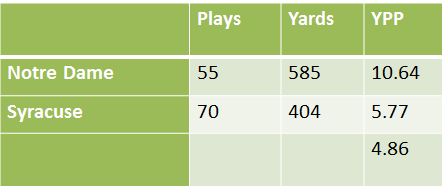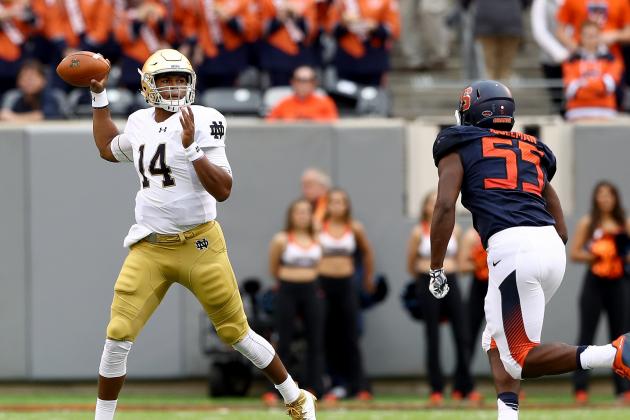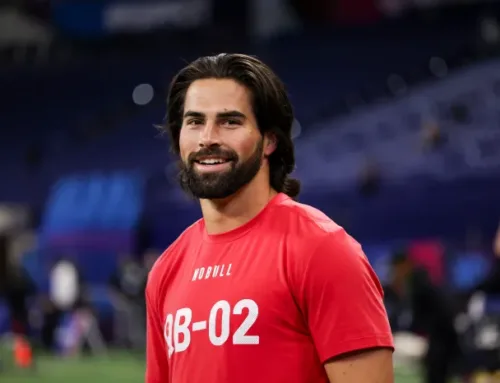Notre Dame’s win over Syracuse reviewed using the Five Factors that lead to success in football. Some encouraging signs for the defense, and the return of esplosiva!
Confused? Check out the advanced-stats glossary here.
Explosiveness

On a yard per play basis, this was a romp for Notre Dame, and the final score should have been a larger margin than 17 points. Taking out garbage time the Irish offense went over 10.5 yards per play, which is obscene even against an incredibly bad Syracuse defense. The explosiveness turned back the clock to 2015 levels for the Irish offense, with scoring plays of 79, 67, 54, and 59 yards.
The huge gainers were a welcome sign for an offense that had maintained a good rate of chunk plays per game from a year ago, but had been unable to hit the home runs of a season ago. Red zone improvement in general, although it was a poor performance Saturday, has been enough to counter some of this regression. But if we expect a little bit of a dip in success turning scoring opportunities into points, then some improvement in explosive passes/runs may be due as well, and I’d gladly make that trade.

Defensively, this was a strong bounce-back performance, and I agree with Eric’s recap – especially relative to the standards that have been set, this was a better game for the defensive side of the ball. There were some extremely ugly moments in the first few series of the game, but after allowing two early touchdown drives, the defense was able to make some adjustments and settle in a bit.
From that point until the start of the 4th quarter, they held 13 Orange drives to a total of 14 points. That included some terrible starting field position thanks to a bad Kizer interception and an equally awful Newsome punt from Syracuse territory that was returned to the Irish 14-yard-line. Throw in all the free chances the Notre Dame defense handed Dungey jumping offsides, and this was not bad, which represents great improvement.
Efficiency

Kizer shredded the Orange defense early and often, and had a very good shot at the Irish single-game passing record if Notre Dame hadn’t opened up a decent lead in the second half. On the ground, this efficiency was a pretty disappointing mark considering the quality of opponent, although there seemed to be more room to work with than in previous contests.
Josh Adams flashed some nice moments as a receiver, but had a pretty ho-hum day otherwise. Early in the game there seemed to be a little too much of an effort to break a long run and stretch things horizontally instead of turning the ball up field and working for a few extra yards.
Is it time to re-set expectations a little bit for this year’s offensive line? Maybe Irish fans have been spoiled by Harry Hiestand’s previous work, but advanced stats think this unit is good at its best and trending towards “above average” in most areas. Notre Dame is currently 35th in adjusted line yards, 53rd in opportunity rate, and 63rd in adjusted sack rate, all of which represent much steeper drop-offs than I would have anticipated from 2015.

The Irish actually had a higher success rate on passing downs than standard downs, which is a pretty rare occurrence but is a testament to just how strong the passing game performed. It’s consistent though with how the offense has operated all season, with a lot of success finding young receivers in the intermediate to deep passing game on 2nd and 3rd and long scenarios.
Defensively, Greg Hudson’s debut was fairly strong against the run against a team miserable at moving it on the ground. The same unit struggled mightily against a Duke offense equally bad at rushing last week, so consider meeting expectations a win for the Hud-dawg.
Through the air things were up and down, but there were some promising streaks of consistent effort. For essentially two whole quarters, from after Dungey’s 36-yard completion to start the 2nd quarter until the end of the 3rd, Syracuse had 30 pass plays go for 116 yards. There’s some fun with arbitrary endpoints involved there (counterpoint: in the 1st quarter the defense gave up 200 yards through the air) but at this point we’ve been looking for spare change in the garbage heap with the defense, and we may have found a few quarters Saturday.
Field Position
Average Starting Field Position
Notre Dame: Irish 26
Syracuse: Orange 32
C.J. Sanders is a ton of fun and I love him forever. The rest of special teams makes one or two plays per game that are making my eyes bleed, Saturday’s prominently featuring the earlier-mentioned punt (a high 36-yarder!) that somehow turned into an instant Syracuse scoring opportunity.
My Justin Yoon concern-o-meter is officially making small whirring noises and beeping now. His slow start in many ways mirrors last season, but I hoped for improvement instead of a similar sophomore slump. Making every kick in the second half of the season is also a really high bar to hit again, and my confidence isn’t there right now.
Finishing Drives

Ugly numbers here for Notre Dame, but they still rank in the top-10 nationally in converting scoring opportunities. This game was a throwback to the 2015 formula – score from a long way away a few times, and it won’t hurt as much if you mess up a few red zone chances.
Brian Kelly must be listening to the message boards, because the Irish have run it about 64% of the time in the red zone so far this season. 43% of those carries have been from DeShone Kizer, which is a vastly higher percentage than in other areas of the field (22%). While it’s been successful so far, there’s been a bit of predictability as of late, so it’s worth keeping an eye on those ratios to see if the offensive staff can exploit those tendencies.
Turnovers
Kizer’s interception before halftime was a very, very bad throw where I imagine he just didn’t see a defender over the middle (Syracuse only rushed three on the play). The Irish were fortunate that Syracuse missed the ensuing field goal attempt and were able to preserve a six-point lead heading to the half.
Notre Dame is now one of only two schools in FBS that has not recovered an opponents’ fumble, along with Toledo. On the bright side, the Irish finally got credit for a forced fumble on a James Onwualu sack on Saturday, their first of the season.





Called it: we doubled our sack count for the year! Now, let’s see if my CFP prediction will come true: ND 11-3! Go Irish!
Great article on Mr Esplosiva at the Ringer. Basically he is still doing Will Fuller things (amazing plays and … drops). Hope this game was the re-ignition of the team’s esplosivaness.
Will Fuller
Thanks for sharing. Awesome article. We knew Fuller had elite speed (right Adoree?) but wow for him to doing the same things against NFL defenses. It shouldn’t be as big a surprise when college defenses have a little easier time with us this year. Perhaps we even underrated Fuller’s presence (though amazing we are still putting up a high amount of explosive plays).
Better keep an eye on the Yoon Concern-O-Meter. I don’t think it’s supposed to make those noises…. either it’s on the fritz, or its worse than we thought….